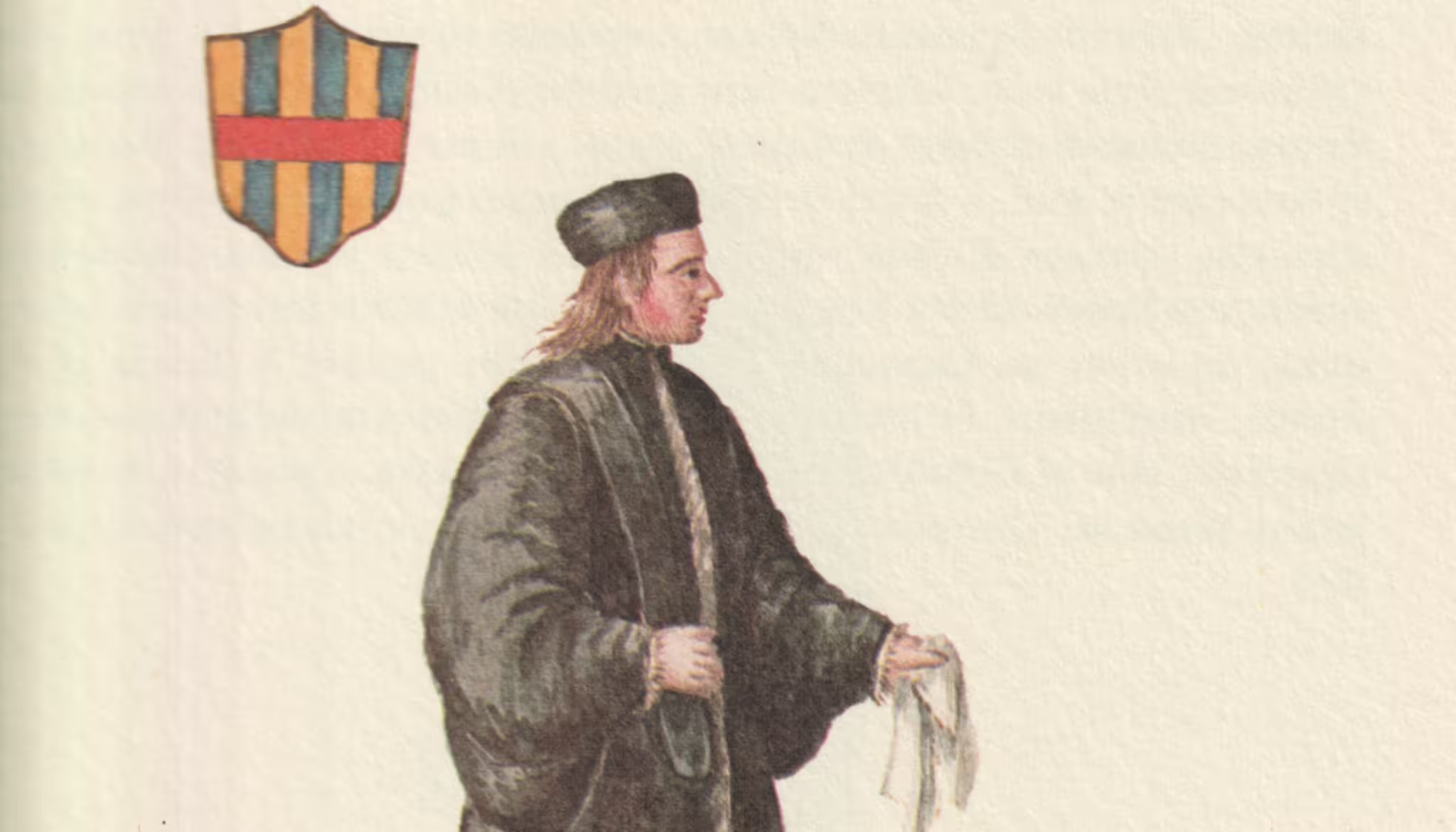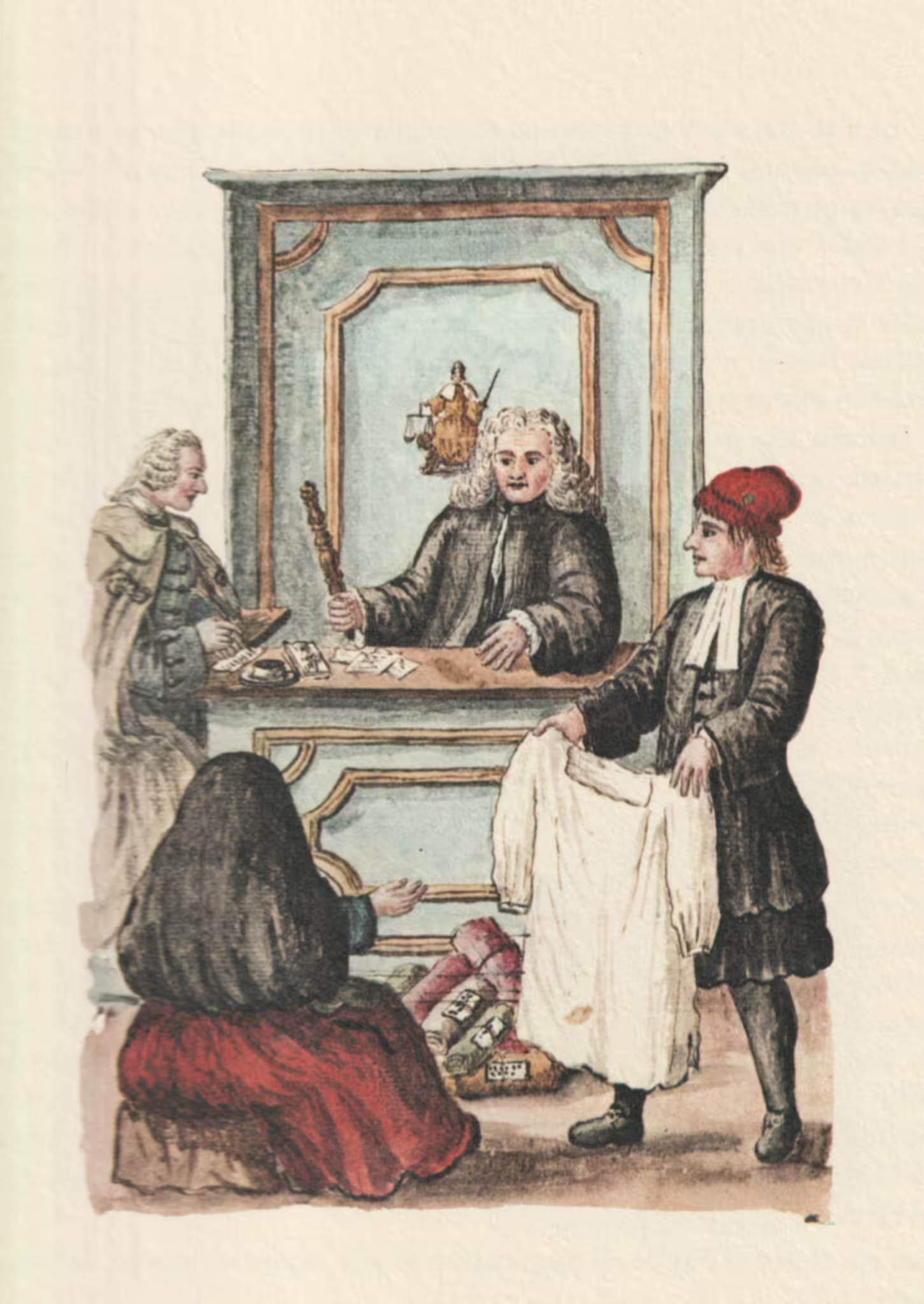This painting depicts the senator Marco Trevisan, who was remembered as a kind of Venetian Cincinnatus — an example of all the virtues of a nobleman of the Republic of Venice.
It is also a good example of the importance of the stola in the dress of Venetian state officials, such as the members of the Pregadi — the Venetian senate.
Source: Gli abiti de veneziani di quasi ogni età con diligenza raccolti e dipinti nel secolo XVIII, by Giovanni Grevembroch (1731–1807), which in four volumes contains over six hundred watercolours of how Venetians dressed in the 1700s.

Nobleman of the House of Trivisan
In the small adjoining space of the Hall of the Anticollegio, a painting is seen depicting the memory of Marco Trivisan, the Oracle of the Venetian Republic, who stands with Senatorial gravity, pointing with his Hand to the Armed Naval, ready to set sail, with the Motto: Hoc vobis iter ad Gloriam.1 Our Patrician wished to demonstrate that the true path to honour and glory consisted in ventures foretold by ways of the sea, given the resolute commitment of the Soldiers to either win or die. When, due to the aggression of Pope Julius II in the 16th century, the renowned League of Cambrai occurred and the unfortunate Battle of Ghiaradadda,2 the Venetian mainland state3 was placed in jeopardy, making it appear imminent that a decision would be made to abandon the City of Venice and transfer the Seat of the Principality to the island of Corfu; at that moment, Trivisan, full of zeal and courage, ascended the Rostrum and spoke as follows:
No one can ever be called a good Citizen who, out of fear or cowardice, thinks of abandoning this beautiful and clear Homeland. Rather, it is more fitting to perish among its ruins than to shamefully flee. Whoever agrees with this generous and just thought should place on the right side that Stole4 which, by custom, he normally wears on the left, and in this manner let the vote of true Citizens be made public. He was the first to display it with such impression that, transferring their own Stoles from one Side to the other, everyone exhibited themselves, both with life and with ability, for the public defence. This worthy action is still remembered today by the behaviour of the Heirs and Descendants of such a Hero, who, unlike any other Noble, take pride in wearing the mentioned Stole on the right side. Moreover, it was the whim of modern Painters to depict it sometimes on one shoulder, sometimes on the other, of Patricians, unless it was supposed that they wanted to distinguish the old from the new, as Brides did in wearing flowers on their chest.
Translator’s notes
- This is your way to Glory. ↩︎
- The Battle of Agnadello (May 14th, 1509), which Venice lost clamorously to the French, during the War of the League of Camrbrai. Enemy forces arrived on the edge of the lagoon for a short while. ↩︎
- The Stato da Terra Ferma (lit. the Mainland State) was all the Venetian mainland dominions, established from the late 1300s. ↩︎
- A stola was a band of fabric, usually the same material as the vesta, hanging over the left shoulder of a magistrato of the republic. ↩︎

Original Italian text
Nobile della Casa Trivisan
Nel picciolo vano contiguo della Sala dell’Anticollegio vedesi dipinta in un Quadro la memoria di Marco Trivisan, l’Oracolo della Veneziana Republica, che sta in piedi con gravità Senatoria, additando con la Mano l’Armata Navale, disposta a far vela con il Motto: Hoc vobis iter ad Gloriam. Voleva dimostrare il nostro Patrizio, che la vera strada dell’onore e della gloria consisteva nelle imprese, vaticinate per via del Mare, stante il risoluto impegno de Soldati, o di vincere, o di morire. Occorsa per l’animosità di Papa Giulio II nel Secolo XVI la rinomata Lega di Cambrai, e la sfortunata Battaglia a Ghiaradadda, era posto in periglio il Veneto Stato di Terra Ferma, per la qual cosa appariva imminente la deliberazione di abbandonare la Città di Venezia, e di trasferire la Sede del Principato nell’Isola di Corfù; quando il Trivisano pieno di zelo, e di valore salito l’Arringo, favellò in tal forma:
Non potrà dirsi giammai buon Cittadino chi per timore, o codardia lasciare pensi in abbandono questa bella, e chiara Patria. Piu tosto conviene perire fra le rovine della medesima, che darsi vergognosamente alla fuga. Chi condescende al generoso, e giusto pensiero, ponga al destro lato quella Stola, che a sinistra per consuetudine tiene, ed in tale guisa sia publicato il voto de veri Cittadini. Egli fù il primo ad esporlo con tanta impressione, che trasferita da tutti dall’uno all’altro Lato la propria Stola, si esibirono, e con la vita, e con la facoltà alla publica difesa. Questa degna azzione viene anche oggidì ricordata dai contegno delli Eredi, e Discendenti di un tanto Eroe, quali a differenza di ogn’altro Nobile vantano portare la detta Stola alla destra Parte. Per altro fù capriccio de moderni Pittori esprimerla, or dall’una, or dall’altra Spalla a Patrizij, quando non si supponesse, che volessero distinguere gli Vecchi da nuovi, come facevano le Spose nel portare gli fiori sul Petto.
Grevembroch (1981), vol. 1, p. 55.
Related articles
Bibliography
- Grevembroch, Giovanni. Gli abiti de veneziani di quasi ogni eta con diligenza raccolti e dipinti nel secolo XVIII, orig. c. 1754. Venezia, Filippi Editore, 1981. [more]





Leave a Reply